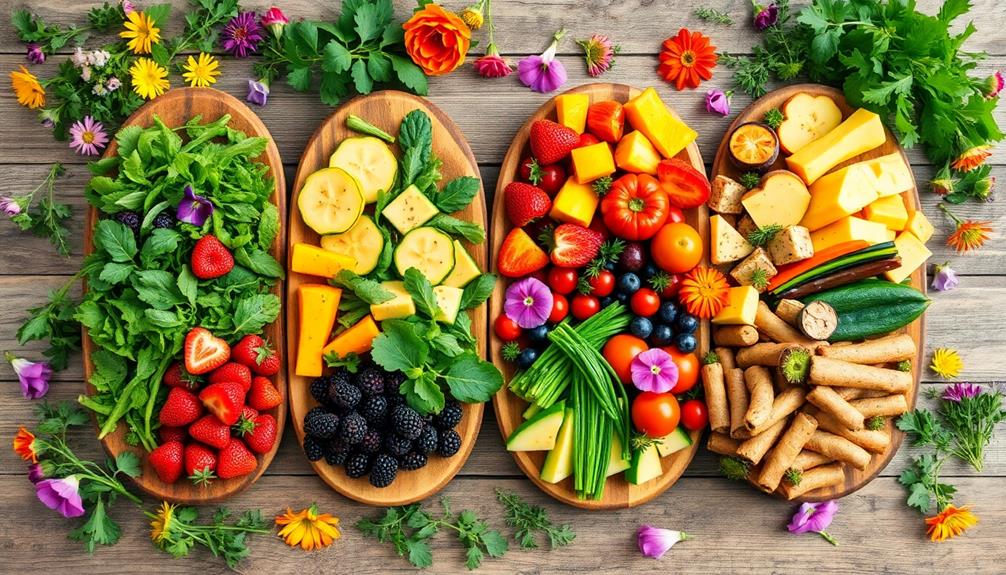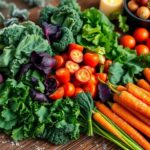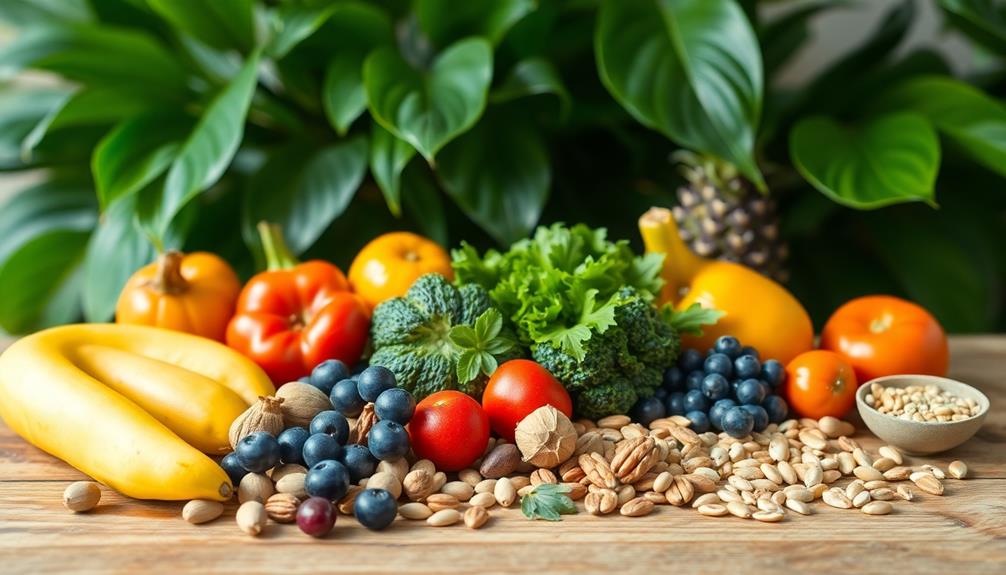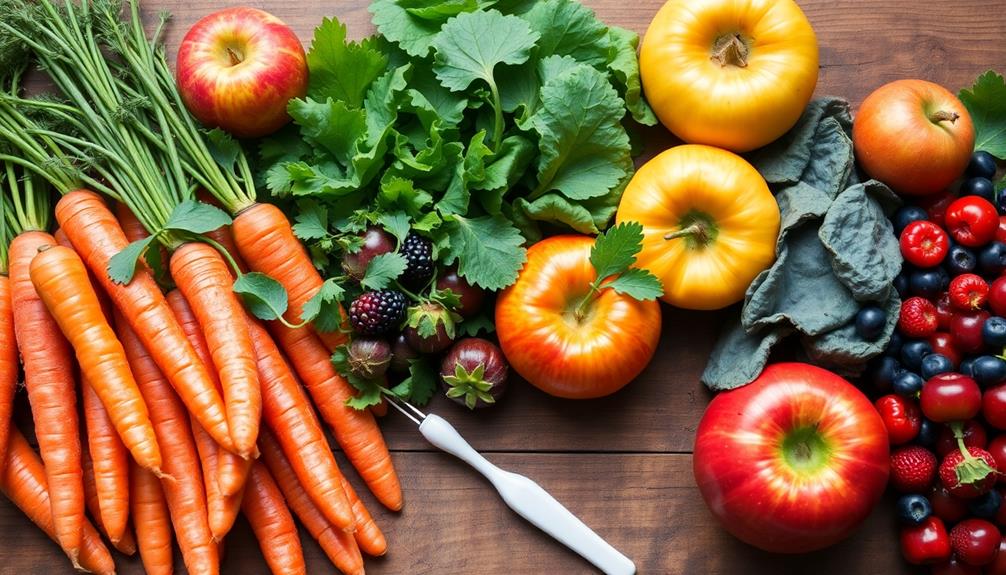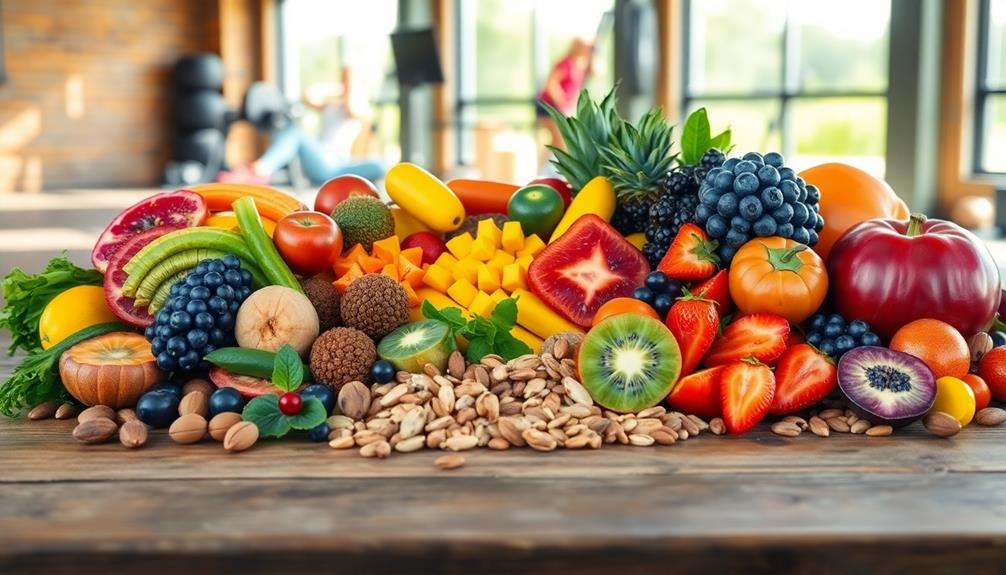Modifying your raw food diet seasonally keeps your meals fresh and exciting. In warmer months, focus on hydrating ingredients like cucumbers and berries, and try chilled soups or smoothies. For colder months, incorporate warming elements like ginger and comforting root vegetables into your meals. Experiment with hearty greens and use spices to enhance flavors while maintaining warmth. Seasonal produce not only boosts taste but also enriches your nutrition throughout the year. If you want to discover a variety of dish ideas tailored for each season, just explore more about how to adapt your raw food recipes.
Key Takeaways
- In warm weather, focus on hydrating ingredients like cucumbers and berries to keep meals light and refreshing.
- Incorporate warming spices like ginger and cinnamon into winter recipes for added comfort and digestive support.
- Use seasonal root vegetables and hearty greens in winter salads to enhance nutrition and warmth without cooking.
- Create chilled soups and smoothies from seasonal produce in summer to maintain a cooling effect and hydration.
- Adjust the balance of raw and cooked foods based on seasonal availability to maximize nutrient density and meal satisfaction.
Understanding Seasonal Eating
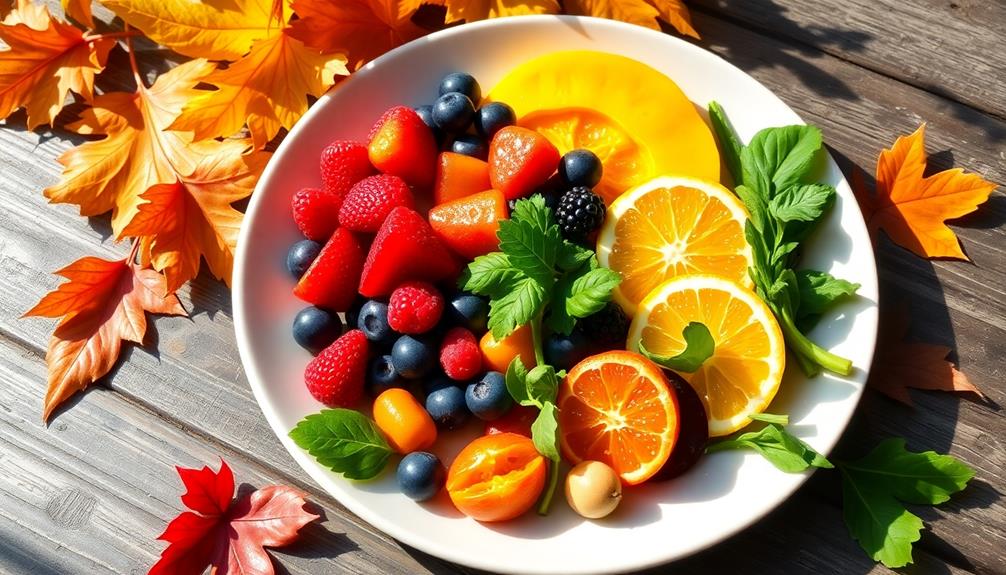
Understanding seasonal eating means recognizing how your cravings and mood can guide your food choices, even when temperatures drop. You might find yourself reaching for seasonal fruit as winter approaches, but that doesn't mean you have to abandon your raw lifestyle. In fact, you can incorporate a variety of raw foods that align with your emotional responses to the season.
For example, juices rich in vitamins can help promote skin health and boost your mood during the colder months, enhancing your overall well-being through health benefits of juice.
Pay attention to how each season influences your preferences. During colder months, you might crave heartier fare, yet still desire the freshness of raw options. Engaging with seasonal produce not only enhances the nutritional value of your meals but also supports local agriculture, making your choices more cost-effective and environmentally friendly.
Mixing raw and cooked foods can help meet your cravings while keeping your meals exciting. By exploring the rich variety of seasonal fruits available, you can create vibrant, nutrient-dense recipes that satisfy both your taste buds and emotional needs.
Benefits of Raw Foods Year-Round
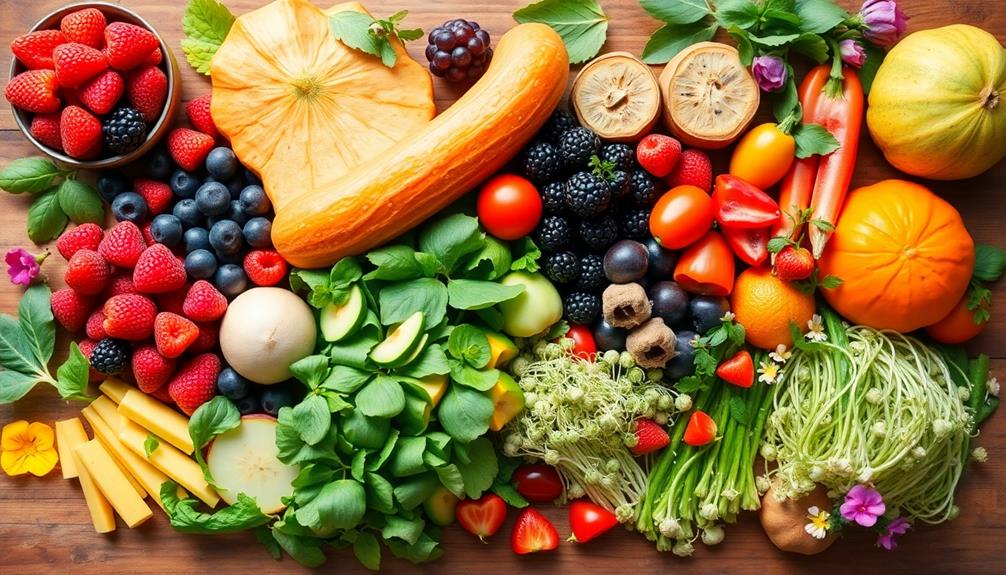
Embracing a raw food diet year-round can greatly enhance your health and vigor. By consuming raw foods consistently, you maintain a high intake of vitamins, minerals, and enzymes that heat can destroy. This approach promotes overall health and wellness, no matter the season.
Seasonal availability of fresh fruits and vegetables allows you to enjoy diverse flavors and textures, enriching your diet with a variety of nutrients. Additionally, adopting an abundance mindset while focusing on raw foods can transform your relationship with food and promote overall well-being.
Incorporating raw foods into your winter meals can considerably benefit your digestion. Raw foods are often easier to digest than cooked foods, helping to lighten the heaviness that comes with winter comfort meals. A high-raw intake during colder months supports your body's natural detoxification processes, counteracting the effects of richer, heavier meals.
Moreover, you can engage in techniques like dehydrating and low-heat methods to enjoy warm dishes while retaining the nutritional benefits of raw ingredients. This flexibility allows you to savor the comfort of warm meals without sacrificing the health advantages of a raw food diet.
Modifying Recipes for Warm Weather
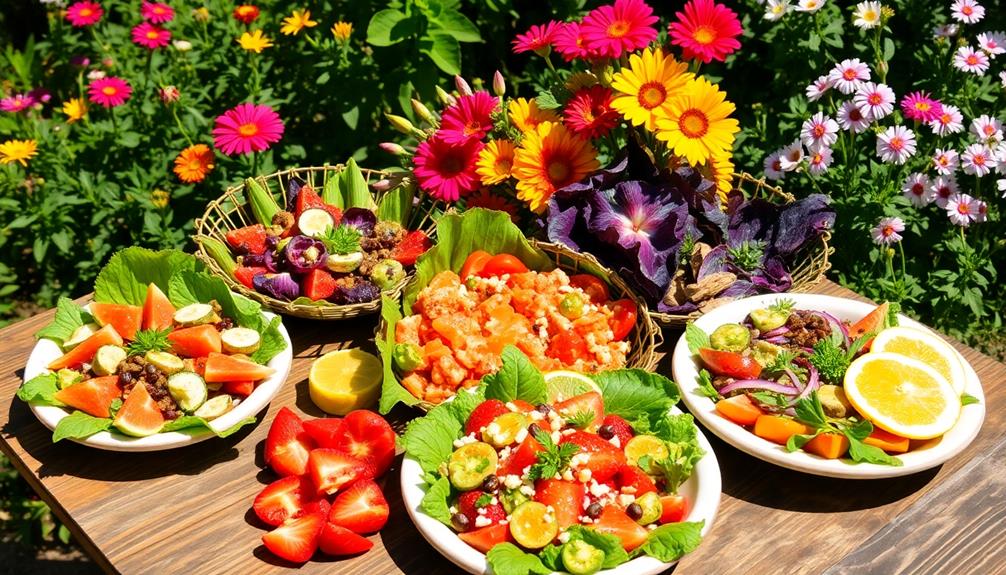
How can you keep your raw food meals enjoyable and revitalizing during warm weather? Start by prioritizing invigorating ingredients like cucumbers, melons, and citrus fruits. These choices not only keep your meals light but also help with hydration.
Incorporating low carb high protein breakfast ideas can also enhance your energy levels during the heat. Chilled soups and smoothies made from seasonal produce are perfect for enhancing that cooling effect while providing a nutrient boost.
To keep your raw diet exciting, opt for lighter dressings. Use citrus juices or vinegars to add zest without the heaviness that can weigh you down in warmer temperatures. They'll complement the fresh flavors of your summer ingredients beautifully.
Don't forget about texture! A dehydrator can be your best friend here. Create crispy snacks like veggie chips or sun-dried tomatoes to add crunch to your meals while maintaining that light feel.
Warming Ingredients for Cold Seasons

As the cold months roll in, you can adjust your raw diet by incorporating warming ingredients that provide comfort and satisfaction.
Think about adding spices like ginger and cinnamon to your dishes or including hearty root vegetables in your salads.
These seasonal tweaks can make your meals not only more enjoyable but also beneficial during chilly weather.
Seasonal Ingredient Adjustments
Winter can be a challenging time for those committed to a raw food diet, but seasonal ingredient adjustments can make all the difference. To keep your meals warm and satisfying, incorporate warming ingredients like ginger, cinnamon, and turmeric. These spice powerhouses not only add flavor but also promote better digestion and circulation, essential during the colder months.
You can also focus on seasonal root vegetables such as sweet potatoes and carrots. Spiralize them into noodles or toss them in raw salads for added heartiness without sacrificing your raw approach. Dehydrated foods, like sun-dried tomatoes or herbs, can enhance flavors and warmth in your dishes, making them perfect for winter.
Additionally, think about incorporating high-calorie raw foods like avocados, nuts, and seeds. These nutrient-dense options help meet your increased caloric needs while providing necessary energy and warmth.
Comforting Raw Meal Ideas
Finding ways to enjoy comforting meals while sticking to a raw food diet can be a delightful challenge during colder months. You can easily enhance your dishes by incorporating warming spices like ginger, cinnamon, and nutmeg into your raw recipes. These spices not only provide soothing effects but also improve digestion and circulation—helping maintain your body temperature.
Consider using a dehydrator to create raw soups and stews. This method warms your meals without compromising their raw benefits, giving you that cozy dining experience you crave. Pair these dishes with seasonal ingredients like roasted root vegetables tossed in a fresh salad to create heartier, more satisfying meals.
Don't forget about hot beverages! A steaming cup of herbal tea or a rich raw hot chocolate made from dates and carob powder can warm you up while satisfying your sweet cravings. Mixing warming spices into these drinks can also boost their comforting qualities.
Incorporating Seasonal Fruits and Vegetables
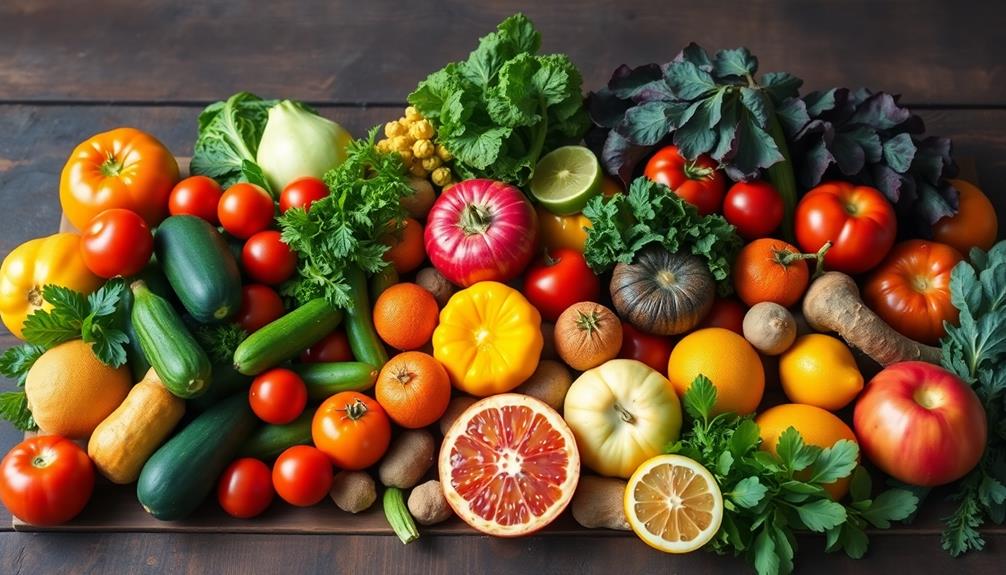
Incorporating seasonal fruits and vegetables into your raw food diet can greatly enhance both flavor and nutrition. By choosing produce that's in season, you're not only enjoying peak freshness but also maximizing nutrient density. For instance, winter brings citrus fruits like oranges and grapefruits, while summer offers a bounty of berries and stone fruits, which add natural sweetness and vibrant colors to your meals.
Local sourcing of these seasonal ingredients can also reduce costs and your environmental impact. When you buy what's in-season, you're likely supporting local farmers and minimizing transportation-related emissions. This method of eating encourages variety in your diet, allowing you to enjoy diverse textures and tastes, such as crispy fall apples and creamy winter squash.
To help with meal planning, here's a quick reference table for seasonal fruits and vegetables:
| Season | Seasonal Fruits | Seasonal Vegetables |
|---|---|---|
| Winter | Oranges, Grapefruits | Carrots, Beets |
| Spring | Strawberries, Cherries | Asparagus, Peas |
| Summer | Berries, Peaches | Cucumbers, Zucchini |
| Fall | Apples, Pears | Squash, Pumpkins |
Nutritional Considerations Throughout the Year
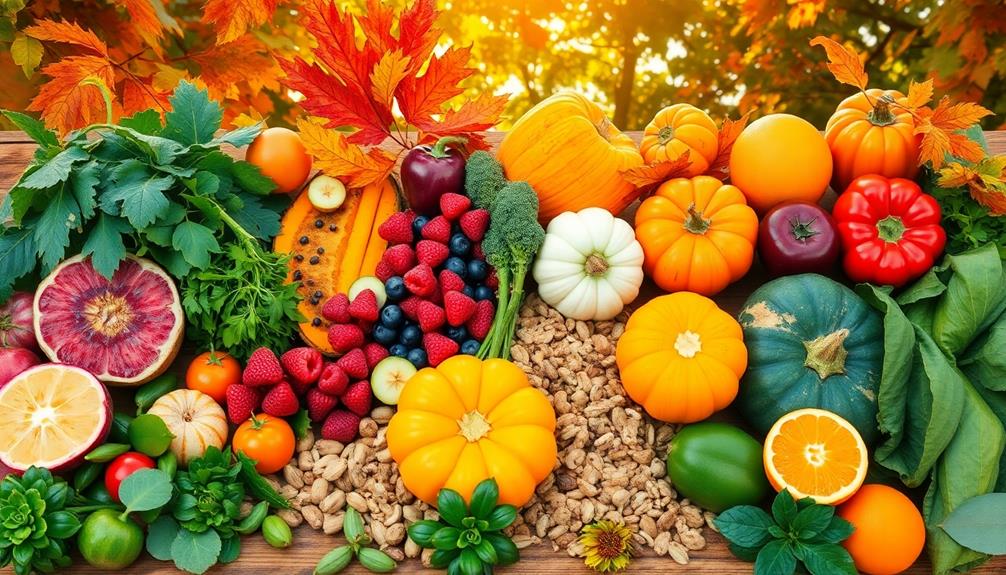
As you navigate your raw food diet throughout the year, adapting to seasonal ingredients is key to meeting your nutritional needs.
Different seasons bring variations in nutrient density, so incorporating a range of fruits and vegetables can help guarantee you get essential vitamins and minerals.
Embracing hearty greens and root veggies in winter while switching to lighter options in summer can keep your meals balanced and satisfying.
Seasonal Ingredient Adaptation
How can you make the most of your raw food diet throughout the year? By embracing seasonal ingredients and local produce, you can enhance both the flavor and nutritional value of your meals.
In summer, indulge in juicy fruits like berries and peaches, which are abundant and packed with vitamins. As the seasons shift to fall and winter, incorporate heartier greens like kale and spinach for their rich nutrients and minerals.
Don't forget about root vegetables like carrots and beets during colder months; they offer essential carbohydrates and fiber.
Spring brings a bounty of sprouts and young greens that aren't only nutrient-rich but also easy to digest.
Adjusting your raw food diet with seasonal herbs and spices can also elevate your meals. Fresh basil in summer and aromatic rosemary in winter not only boost flavor but also provide additional health benefits.
Nutrient Density Variations
Understanding nutrient density variations throughout the year can greatly enhance your raw food diet. By focusing on seasonal produce, you can guarantee you're getting the best nutrients to support your health. Each season offers unique fruits and vegetables that peak in nutritional content, so it's important to adapt your diet accordingly.
Consider these emotional benefits of embracing seasonal produce:
- Boosts your immune health with winter crops like kale and sweet potatoes.
- Hydrates and refreshes your body with summer berries and stone fruits.
- Broadens your nutrient spectrum, guaranteeing you get a variety of vitamins and minerals.
- Satisfies your cravings while keeping your meals exciting and vibrant.
As a raw vegan, remember that nutrient density varies considerably. In winter, you might find more value in lightly cooked seasonal vegetables to enhance nutrient absorption.
In the summer, indulge in fresh, hydrating fruits that are high in antioxidants. By adjusting the balance of raw and cooked foods based on seasonal availability and your personal cravings, you can maintain ideal health and satisfaction throughout the year.
Embrace the changes, and enjoy the journey of nutrient-rich eating!
Meal Preparation Tips for Seasonal Changes
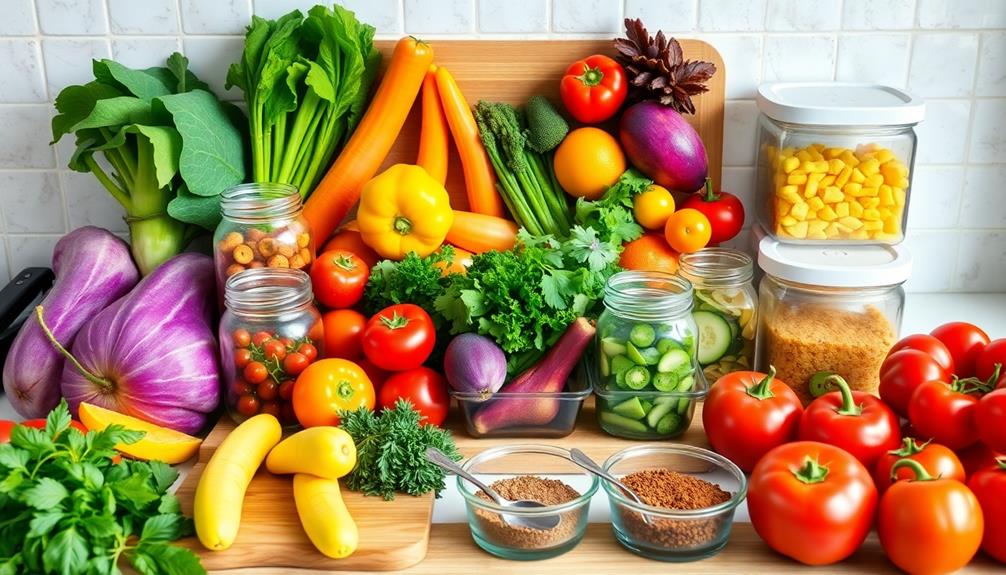
Adapting your raw food meal prep to the changing seasons can make a significant difference in both flavor and nutrition.
During colder months, focus on incorporating seasonal ingredients like winter root vegetables and hearty greens. These not only enhance warmth and comfort in your meals but also provide essential nutrients.
Consider using a dehydrator or low heat for warming soups and stews, allowing you to enjoy raw meals with a cozy feel.
As the temperature drops, it's wise to increase your caloric intake by 100-300 calories. You can achieve this by adding more nuts and seeds to your meals.
Experiment with hot beverages like herbal teas or warm smoothies to complement your raw diet in winter. They help keep you warm while using raw ingredients.
In contrast, during the summer, prioritize high-water content fruits and vegetables to stay hydrated and refreshed.
Opt for lighter meals that help you feel energized.
As the seasons change, these meal preparation tips will guarantee you're not only satisfied but also nourished, making your raw food journey enjoyable year-round.
Community Support and Resources

A strong community can make all the difference when you're maneuvering the raw food diet. Engaging with others on this journey not only boosts your confidence but also opens up a wealth of resources. Online forums and vegan communities are fantastic for knowledge sharing and support, so don't hesitate to immerse yourself.
Here are some ways to connect and find help:
- Join local groups for networking with experienced raw feeders who can offer practical advice.
- Participate in community challenges, like the Daily Salad Challenge, to inspire creativity in your meals while feeling a sense of belonging.
- Explore specialized websites such as k9rawdiet.com for valuable resources, including raw feeding principles and recommended reading.
- Seek mentorship or professional guidance from nutritionists or veterinarians to enhance your understanding and guarantee balanced dietary practices.
Creative Recipe Ideas by Season

Seasons bring a delightful variety of flavors and ingredients to your raw food diet, making it the perfect time to get creative in the kitchen. Embracing seasonal ingredients not only enhances the freshness of your meals but also allows you to explore comforting flavors throughout the year.
Here's a quick guide to inspire your seasonal raw recipes:
| Season | Ingredients | Recipe Ideas |
|---|---|---|
| Spring | Asparagus, Peas | Fresh salads, Raw spring rolls |
| Summer | Watermelon, Berries | Chilled salads, Frozen berry treats |
| Autumn | Squash, Root vegetables | Raw soups blended with spices |
| Winter | Cinnamon, Ginger | Spiced smoothies, Dehydrated desserts |
In spring, whip up vibrant salads featuring asparagus and peas. Summer's juicy fruits shine in chilled watermelon salads. Autumn invites you to create hearty raw soups with root veggies, while winter lets you warm up with spiced smoothies and crunchy dehydrated snacks. By adjusting your raw diet seasonally, you can enjoy a comforting variety of flavors all year round!
Frequently Asked Questions
What Are the Limitations of a Raw Food Diet?
A raw food diet has limitations, like potential nutritional deficiencies, digestive discomfort, and social isolation. You might struggle with ingredient availability in colder months and face high initial costs for specialized equipment.
What Is the Biggest Problem With Mixing Raw Foods Together With Cooked Foods?
Imagine a traffic jam; that's your gut when you mix raw and cooked foods. It causes bloating and discomfort because they digest at different speeds, making it harder for your body to absorb nutrients efficiently.
What Will Happen if a Person Eats Only Raw Food for a Month?
If you eat only raw food for a month, you'll likely feel more energetic initially, but you might also experience digestive discomfort. Nutritional deficiencies could arise, and social situations may become challenging due to your dietary restrictions.
How to Transition to a Raw Food Diet?
Shifting to a raw food diet might feel like jumping into a vibrant, kale-infused ocean! Start slowly, blending fresh fruits and crunchy veggies into your meals, and soon you'll swim effortlessly in this colorful lifestyle.
Conclusion
As you embrace the raw food diet year-round, remember that "variety is the spice of life." Seasonal eating not only keeps your meals exciting but also supports your health by aligning with nature's rhythms. By modifying your recipes and incorporating local produce, you'll enjoy fresh flavors while reaping nutritional benefits. So, get creative in the kitchen, experiment with seasonal ingredients, and share your delicious discoveries with others—your taste buds and body will thank you!

